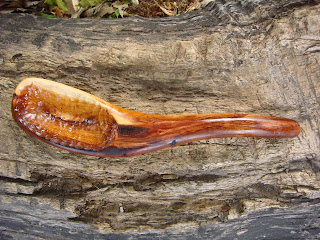Sometimes it’s nice to examine symmetry not in the traditional sense of form and proportion but instead to relish the patterns created by nature. I frequently do that when making a spoon. First, however, one needs to take the time to do some anatomical exploration.
While naturalists are adept at identification and classification, the exercise usually stops short of any sort of dissection. That’s where the biologist enters and perhaps that part of me remains imprinted on my woods roaming lifestyle. I draw the line, however, when it comes to animals because I’d rather listen, for example, to a mourning dove cooing than shoot it for food or cut it open to inspect its innards.
But plants are a different matter. I’m not content to walk by a plant—especially one I’m unfamiliar with—and simply look at the leaves or flowers or touch its thorns or maybe examine its bark. No, I’ve got to look inside. I’ll saw off a small branch and scrutinize its insides from sapwood to heartwood. Then I’ll pluck a few leaves and take them home to view under the stereoscope. That, by the way, opens a whole new world to those who choose to look. I want to smell every plant I encounter as well. Then I’ll dry the branch and determine its specific gravity. Finally, I’ll carve the wood with my crooked knife and perhaps in the most revealing way that tells me things about the wood that are beyond simple explanation.
And that brings me back to spoons. Here are some spoons I completed recently that were never intended to be spoons, at least not in the traditional sense. Over the years, I have discovered plant species that, once opened up, revealed a wonderland of form and figure. And color as well.
“What does it look like inside?” “What does it feel like?” “How will it react to my crooked knife and my hook knife?” Those are the questions I’m asking myself when I see a plant species I’ve never encountered before.






No comments:
Post a Comment